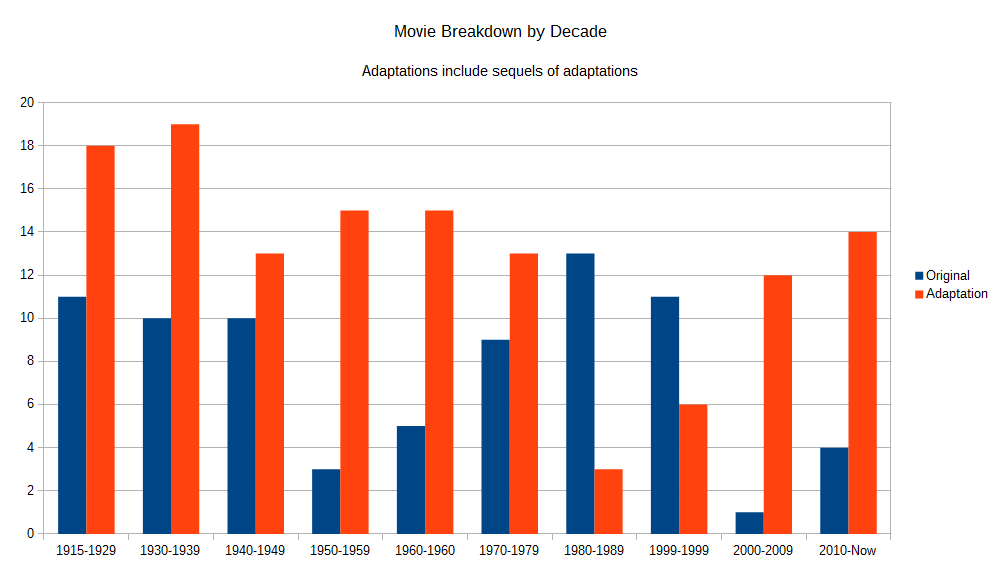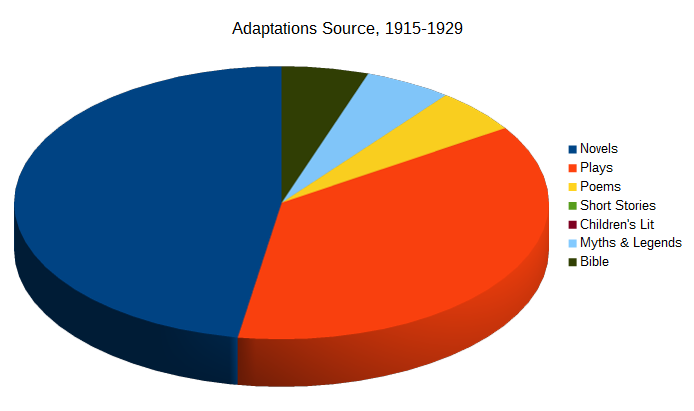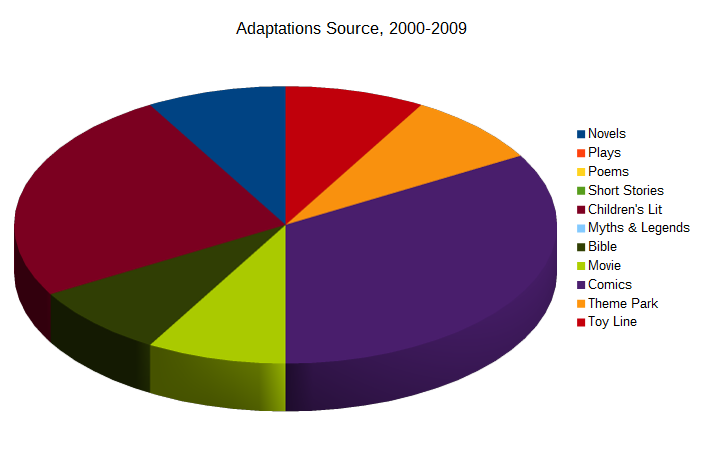The History of Adaptations
Twenties
Thirties
Forties
Fifties
Sixties
Seventies
Eighties
Nineties
Aughts
New Teens
Welcome to the history of adaptations. I’ve been looking at the top movies of each decade, analyzing them to see which ones were original and which ones were adaptations, and of the adaptations, what the source material was. I’m using the compiled list at Filmsite.org as a base. With the New Teens completed up to now, it’s time to figure out what all this means.
First, though, my methodology. I needed a start point, thus my use of the list at Filmsite.org. The list provided me with a base to work from. I chose the popular films, as according to box office, because the films should be memorable enough and have lasting impact on films even today. Even Ingagi, released in 1930 and pulled when it was discovered that the found footage was found in other movies, still has ripples in the form of Gorilla Grodd, who has appeared in the current TV series, The Flash. While box office takes reflect how much money a movie made at the theatres, it does ignore the effects of television airings and the sale and rental of home videos, both video tape and DVD/Blu-Ray. Some classic films, including Casablanca and Psycho, gain an audience long after leaving theatres. Popular films also may not be representative of the films released. There aren’t many Westerns on the list, yet the genre was a staple for several decades.
Going through every film released, though, would be a huge undertaking. The goal of the project was to discover whether movie adaptations were a recent approach or if it was something happening throughout the history of film. The Filmsite.org list starts with 1915’s The Birth of a Nation. One hundred years of film history to examine. I needed a way to get a sample of what was released. Again, the popular films may not be representative. Statistically, I haven’t run the numbers. In the more recent decades, studios have shown a tendency to follow the leader; if one studio has a breakthrough hit featuring an alien invasion/romantic comedy, every studio will make a similar film to get a piece of the action. Whether that holds true for the earlier years of Hollywood remains to be researched.
Throughout the project, I broke down the films into original and adaptations, making note of where a film didn’t quite fit into either. I placed sequels under original unless the sequel itself was based on another work. Movies like Lord of the Rings: The Return of the King and The Hunger Games: Catching Fire are both sequels and adaptations, both being based on books in a series. The categories aren’t perfect, though breaking the movies into finer categories would dilute the numbers to the point of uselessness. The most films in one decade was 29, in 1915-1929 and 1930-1939. The fewest, 13, came in 2000-2009, which was also the decade with the fewest original works on the Filmsite.org list. The graph below shows the number of original movies versus the number of adaptations by decade. On the left, in blue, is the number of original works. The right, in orange, is the number of adaptations.
As the above shows, only two decades had the number of original movies outnumbering the adaptations. With all the complaints about the number of adaptations, the Eighties and Nineties, still fresh in people’s minds, were the exception. My expectation when I started was that the early years would have a large number of adaptations as scripts for stage were repurposed for film, but the Fifties showed otherwise. The Fifties were the first decade to have a huge number of remakes, too.
If the Eighties and Nineties were the exception, then why the complaints? The next few graphs might shed some light. I chose three separate decades, the Early Years, the Fifties, and the Aughts, to show what sources were used for adaptations.
Novels and plays are the bulk of the adaptations. Neither take over half, but the literary tradition is there. The other three sources, poems, myths and legends, and the Bible, aren’t that much different. The era is literary.
In the Fifties, novels and plays are major sources in adaptations, but other works are appearing. The number of remakes equal the number of movies using plays as a source. Myths and legends have a larger piece of the pie than in the Early Years. Children’s literature is a new source, thanks to Disney, but poems are still being used.
With the Aughts, the literary sources drop. Novels and plays combined equal the number of movies based on children’s literature. Comic books are a bigger source. The Aughts also had movies based on sources not seen in the previous decades – toy lines and theme park rides.
The Aughts may be showing why there is a complaint about the number of adaptations. The source work is far better known today. A movie based on one of Shakespeare’s plays passes the acceptance test. A movie based on a line of action figures is being made because either the toy line is selling well or the toy company wants to sell more of the toys, and thus can irk people. The same holds with using children’s literature and Young Adult works; there’s a feeling of catering to a younger audience that alienates older viewers.
Adaptations aren’t a new phenomenon. They’ve been around since the beginning of the film industry and will be around until the industry collapses. Film making is expensive. Studios need to pull in an audience, and, if done well, adaptations of popular works will draw in the crowd.








